Explanation of terminology
There is some ambiguity in English about the meaning of the word "container" (from the Latin: continere = to enclose), but for the purposes of this Handbook the word should be taken to mean a shipping container, whether large or small.
The American Heritage Dictionary of the English Language defines a container as a "large reusable receptacle that can accommodate smaller cartons or cases in a single shipment, designed for efficient handling of cargo". In common American parlance, this type of container is often called a "van", although a van is defined in most dictionaries as a motor vehicle or truck or wagon.
In the past, the term container, when used in the field of goods traffic, was taken to mean standardized transport units of different types, whose dimensions were so matched to one another that they could be combined together as "transport modules". This is still generally true today; however, usage of the term has moved more and more towards large or bulky containers, which are transported by road, rail, water and (in modified form) even by air.
This part of the Container Handbook deals in particular with the packing and securing of cargoes in freight containers. However, the packing and securing instructions are equally applicable to CTUs as defined in the CTU guidelines.
The "Guidelines for the packing of cargo, other than bulk cargo, into or onto cargo transport units (CTUs) applicable to transport operations by all surface and water modes of transport", in force since 17th February 1999, define the following terms:
-
For the purposes of these guidelines, the term "Cargo Transport Unit" ("CTU") has the same meaning as the expression "Intermodal Transport Unit" ("ITU") and the following definitions apply:
-
cargo transport unit (CTU) means a freight container, swap-body, vehicle, railway wagon [railroad car] or any other similar unit.
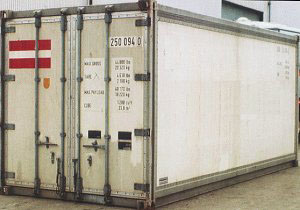 |
Freight container, in this case a partially ventilated 20' plywood box container |
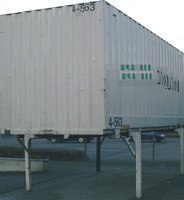 |
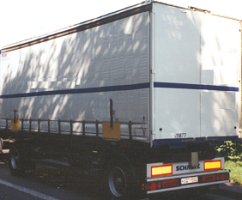 |
|
| Swap-body | Vehicle |
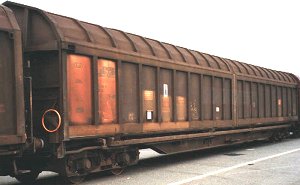 |
Railroad car, in this case a sliding wall bogie car |
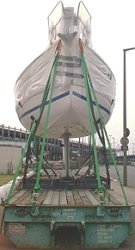 |
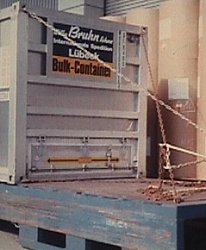 |
|
| Other CTUs: | ||
| Roll trailers | Cassette | |
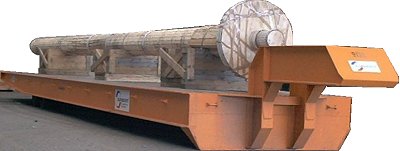 |
|
| Other CTU, in this case roll trailer: |
-
Freight container/container means an article of transport equipment that is of a permanent character and accordingly strong enough to be suitable for repeated use; it is designed to transport a number of receptacles, packages, unit loads and overpacks together from the packing point to its final destination by road, rail, inland waterway and/or sea without intermediate separate handling of each package, unit load or overpack. The term "container" is used throughout these guidelines.
 |
Freight container/container, in this case 40' high-cube steel corrugated container |
... the "permanent character, sufficient strength and suitability for repeated use" are no use, however, if a container is incorrectly packed and secured.
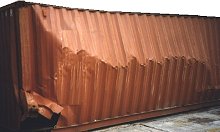 |
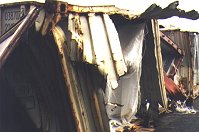 |
|
| Damage to containers due to packing and securing deficiencies | ||
-
Intermediate Bulk Container, (IBC) means a rigid, semirigid or flexible portable packaging that:
- has a capacity of not more than 3.0 m³ (3,000 liters) for solids and liquids;
- is designed for mechanical handling; and
- is resistant to the stresses produced in handling and transport, as determined by tests.
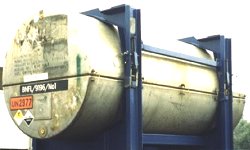 |
 |
|
| Rigid IBC | ||
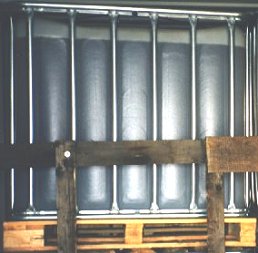 |
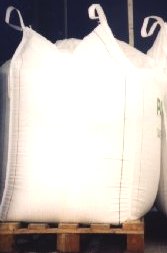 |
|
| Semirigid IBC | Flexible IBC, in this case a Big Bag |
-
Intermodal Transport Unit (ITU) means a container, swap-body or semitrailer suitable for intermodal transport.
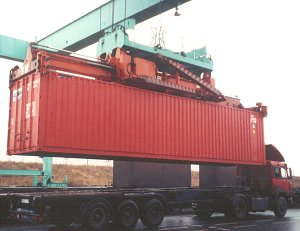 |
Freight container used for intermodal transport |
| Swap-body used for intermodal transport | 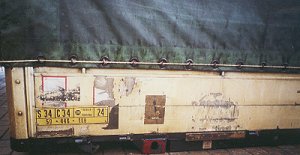 |
 |
|
| Articulated truck consisting of truck tractor and trailer used for intermodal transport |
- Swap-body means a CTU with at least four fittings for accommodating twist locks that take into account ISO standard 1161:1983 not permanently attached to an underframe and wheels or to a chassis and wheels. A swap-body need not be stackable but is usually equipped with support legs, designed especially for combined road/rail transport.
 |
Swap-body |
The term swap-bodies has come to be used in modern German parlance.
- Vehicle means a road vehicle or railway freight wagon [railroad freight car], permanently attached to an underframe and wheels or to a chassis and wheels, which is loaded and unloaded as a unit. This term also includes a trailer, semitrailer or similar mobile unit except those used solely for the purposes of loading and unloading.
| Road vehicle | 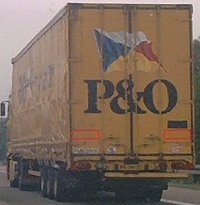 |
 |
|
| Railroad car |
A distinction is drawn according to size between:
- Large containers
- Medium containers
- Small containers
This handbook deals in particular with cargo securing in large containers, with the main emphasis on those which spend at least part of their journey at sea. In principle, the cargo securing rules set out also apply to other containers. So-called pa containers are medium containers designed especially for rail transport. Small containers are used in groupage traffic and are carried by both road and rail vehicles. Neither of the above-mentioned groups will be dealt with here, however.
Depending on container design and the applicable standard, the following distinctions may be drawn:
- ISO container (also known as an overseas container or transcontainer)
- ASA container
- ISO inland container
An international standard is necessary for the standardization of transport and handling operations, e.g. to ensure uniform practice in the picking up and setting down of containers using lifting gear and ground conveyors or the marking of containers. In addition, a series of other national and international publications, some of which have legal force, cover the widest possible range of characteristics of these special containers for rationalized goods transport or give instructions for their use.
We shall not list the individual standards here, as they are of only limited relevance to packing and cargo securing. Should a particular standard be of relevance, the reader will be referred to it.
Technical Committee 104 (TC 104) of the International Organization for Standardization (ISO) was involved in drawing up many of the ISO standards. German interests were represented with regard to some standards by the ISO Container sub-committee (SC). The international standards are applied in Germany as DIN ISO or these days for the most part as DIN EN ISO.
One important regulation which has legal force has been published in the German federal law gazette as the "Internationales Übereinkommen über sichere Container (CSC)" [International Convention for Safe Containers]. The Convention defines the term container as follows:
Article II
Definitions
Definitions
For the purpose of the present Convention, unless expressly provided otherwise,
| 1. | "Container" means an article of transport equipment | ||
| a) | of a permanent character and accordingly strong enough to be suitable for repeated use; | ||
| b) | specially designed to facilitate the transport of goods, by one or more modes of transport, without intermediate reloading; | ||
| c) | designed to be secured and/or readily handled, having corner castings for these purposes; | ||
| d) | of a size such that the area enclosed by the four outer bottom corners is either: | ||
| I) | at least 14 sq. m. (150 sq. ft.) or | ||
| ii) | at least 7 sq. m. (75 sq. ft.) if it is fitted with top corner castings. | ||
| The term "container" includes neither vehicles nor packaging; however, containers when carried on chassis are included. | |||
In both DIN ISO 668, entitled "Series 1 ISO containers - Classification, dimensions and ratings" and in DIN ISO 830 "Containers - Vocabulary", containers are defined as follows:
- Container: a transport container which
- is of a permanent character and accordingly is strong enough to be suitable for repeated use,
- is specially designed to facilitate the transport of goods, by one or more modes of transport, without intermediate reloading,
- is suitable for mechanical handling,
- is designed to be readily packed and unpacked,
- has a capacity of at least 1 m³.
- Vehicles and packaging are not containers.
In principle, the only difference between the "International Convention for Safe Containers (CSC)" and the DIN ISO standards is that the former provides for a container surface area of at least 14 m² or 7m², as a function of the corner castings, while the latter deem receptacles with volumes of 1 m³ or more to be containers.
We will not at this point go into the specific definitions of the term container given in hazardous materials legislation, but if the need arises, the relevant references will be cited at the appropriate point.